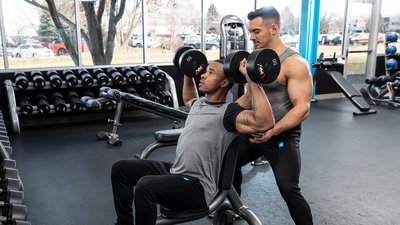The first time I encountered a personal trainer, we almost got into a fight. Even though the gym's weight room was nearly empty that afternoon, the trainer was hogging equipment and taking up way more space than he or his client needed. The last straw was when he stuck his butt in my face while spotting his client on the bench next to mine.
We had words but avoided violence, and in the end, both of us learned something. I learned that "personal trainer" is a profession, and he (hopefully) learned that his profession doesn't come with a license to act like a dick.
Today, more than 30 years later, everyone knows about personal trainers. There are more than 300,000 of them in the U.S., and the Bureau of Labor Statistics expects a 10 percent increase by 2026. After all, the number of college graduates with exercise science degrees has increased dramatically this decade, as well.
But make no mistake, a college degree doesn't even guarantee you an entry-level job. Most gyms still require at least one personal training certification before they'll give you a company shirt and put you on the floor. And once you're on the floor, you have to attract and retain clients.
And that's just the beginning. To actually have a career as a personal trainer, one that provides a good income for doing work you love, you need to make some critical choices: What do you need to know? Should you specialize in a specific type of client or training? How do you get attention and build your profile?
To find the answers, I asked nine of the most accomplished fitness professionals I know to share their best advice for up-and-coming trainers.
Master the Basics
More often than not, trainers become trainers because they love training. Many are lifelong athletes and gym rats with a passion for finding new challenges. But that's the opposite of what the average client needs, says Meghan Callaway, a personal trainer in North Vancouver, British Columbia.
"So many coaches underestimate the importance of becoming really proficient with basic exercises, and having a wide array of regressions, progressions, and modifications," she says. "Too often, they assume flashier and more advanced exercises are better, or more entertaining."
Start working with people, and you'll see quickly that few clients are actually ready for technically complex movements, and none need to be entertained. They need to be trained! Even with a more advanced client, as rare as they are for an inexperienced coach, you'll probably still get the best results by focusing on fundamental exercises and methods.
"When in doubt, basic works best," Callaway says.

Fill Your Toolbox
Sticking to the basics doesn't mean using the same exercises every single workout. It's not even an option if you train clients in a crowded gym; you'll need alternatives when you can't get to the equipment you want.
For this reason, a good trainer should know at least 37 variations for every major movement pattern—press, row, pull-down, squat, lunge, and hip hinge.
Where does that number come from? Nowhere. I just made it up. But I'll bet every experienced trainer reading this article could get pretty close to 37 variations for each one.
Ethan Benda, a personal trainer in Kansas City, Missouri, offers this challenge: Can you come up with a solid total-body workout using just one moderately heavy dumbbell—and then scale it for both a basic and advanced trainee? This is how he would do it:
One-Dumbbell Workout
Basic workout: 2-3 rounds
Superset
- Front-loaded reverse lunge 10-20 reps per leg
- Split-stance row 10-20 reps per arm
Floor press 10-20 reps per arm
Triset
- Front squat 10-25 reps
- Pull-over 10-25 reps
- Shoulder press 10-25 reps
Advanced workout
Superset
- Front-loaded jumping split squat 5-10 reps per leg
- Bent-over row 10-20 reps per arm
Floor press with slow eccentric 10-20 reps per arm
Triset
- Explosive front squat 10-25 reps
- Single-arm pull-over 10-25 reps per arm
- Full-range push-up 10-25 reps
Benda shows the exercises in this video.
Don't Rush into a Specialty
Think of a trainer who's well known, and chances are it's because of the trainer's specialty: Bret Contreras and glute training. Eric Cressey and pitchers. Mark Verstegen and top NFL draft picks.
This may lead you to think the path to success starts with narrowing your focus to a particular type of client or training system. It usually doesn't.
"Specialization is sexy," concedes Kevin Mullins, a master instructor with Equinox in Washington, D.C. "But it comes at the expense of depth. The generalist is best suited to move the needle with the population that hires trainers most often."
Not only that, the skilled and experienced generalist is in the best position to succeed with a niche. That's because the market tells good trainers what they do best. Satisfied clients recommend the trainer to people like them, while other coaches see those results and refer people with similar goals.
How long does it take?
"A minimum of 5,000 sessions with individuals or small groups," Mullins estimates, which equates to 3-4 years of full-time training.
Earn Multiple Certifications
I noted earlier that most gyms require a basic credential before they'll hire a new trainer. Unfortunately, that doesn't tell you which one you'll need! If you aren't sure which one to pursue, check out Jonathan Goodman's guide to personal training certs.
But that's just the beginning for an ambitious fitness pro. Danny King, national manager of team member development for Life Time, says the top-earning and most in-demand trainers typically have at least three specialty certifications.
One reason is institutional. "More certifications get you a better title of some type," King says. At Life Time, for example, "a Level 5 trainer has more certifications than a Level 1, and clients and members tend to gravitate to the higher-level trainers."

But probably more important, he says, "is the confidence and skill associated with learning." And not just learning from a book or seminar, "but actually passing a test and receiving a certificate."
Develop Your People Skills
Credentials only take you so far, says Chad Landers, owner of Push Private Fitness in Los Angeles and NSCA Personal Trainer of the Year in 2018.
"Most clients have no idea about degrees or certifications, or if something is being done incorrectly or dangerously," he says. "What they do know is their trainer makes them feel good while they're with them, and good about themselves when they're not."
If nothing else, Landers adds, "You need to be able to talk about something other than training and nutrition. The more you have in common with clients and prospects, the better."
It should go without saying (but still needs to be said) that you also need to make sure you're respectful of boundaries and appropriate relationships in the gym.
Get Attention Close to Home
Social media can distort a young trainer's perception of what success looks like in the fitness industry. While some do a great job of monetizing their "influencer" status, there's no clear correlation between income and popularity.
"Unless you run an online business and have outstanding authority, social following probably won't drive dollars into your business," says Lisa Simone Richards, a PR consultant for fitness pros.
What does work? Local publicity: writing articles for a community newspaper, appearing on local radio, getting a TV station to cover an event at your gym.
"It's a free way to get exposure and attract clients, especially for brick-and-mortar trainers," she says.
Yes, it seems like small potatoes when you compare it to a global platform like Instagram. But which is more likely to reach people who might actually check out your gym and consider hiring you?
One highly underrated way to raise your profile and credibility is to win a "best of" award. Every city or region has a newspaper, magazine, or radio or TV station that gives them out each year. "You'd be surprised how many people don't apply for them, assuming they'll never win," Richards says.
They may be right when it comes to awards like "best gym" or "best personal trainer" in their area. The same people tend to win year after year. But you can increase your odds by asking organizers to create a new category that's specific to your business. "Best sports-performance facility," for example, or "best group-cycling instructor."
Once you enter, Richards says, make sure your clients and gym members know about it, and give them incentives to vote for you.

Even if you don't win, you raise your profile in your gym or community, and that opens up new opportunities.
Train Clients Online
Potential clients who can't train with you in person will sometimes ask you to train them online. Same with clients who travel a lot. Same with friends or relatives of clients who've heard you're awesome but don't live in your area. So be ready for it, because it can definitely help make your training business explode.
The first and biggest benefit is the income.
"I can still work with online clients while traveling," says Dean Somerset, a trainer and post-rehab specialist in Edmonton, Alberta.
It smooths out your take-home pay so you're not scrambling to pay the rent when half your clients get sick or go on vacation at the same time.
It also makes you a better trainer.
"One of the biggest challenges about online training is also its biggest gift," Somerset says. "Because I'm not in the same room as the client, and can't tap a muscle to say 'this is where you should feel this working,' it's a much harder process to communicate what I need from them, and to get them to buy in to what they should be doing."
Training clients online forced Somerset to improve his communication and coaching skills, both in person and in writing. He also started shooting his own videos and built up an extensive movement guide library on YouTube. The more content he created and shared, the more opportunities he received to write and present, in addition to training as many clients as he could handle, both in person and online.
Somerset became influential without ever trying to pass himself off as an "influencer."
Create a Client Avatar, and Become That Person's Hero
Suppose you train clients entirely or mostly online. You'd think a large audience would be the key to your success. But it's not how many followers you have that matters, it's whether the people who follow you are willing to spend money on your products or services.

Take Brittany Byrd, for example. Despite a minuscule audience (her Instagram account is private, with just 1,000 followers), her business is thriving. The reason is simple: She focuses on one type of client—women, in her case—and tries to be the best possible coach for that client.
If you've been training clients long enough to specialize in a single niche, here's the process Byrd recommends:
- "Write a list of all the attributes you love about current clients, and all the things you dislike," she says. That's your client avatar, and your social media content should speak to that person as directly as possible.
- Lean into whatever makes you unique. "When I think of my favorite entrepreneurs, they make you feel like you know them," Byrd says. "Do the same for your audience. There's only one you, so remember to authentically be yourself."
- Everyone's least-favorite entrepreneurs are the ones who only post when they have something they're trying to sell. No matter how much you like the person or the product, you don't want to be treated like the commercial equivalent of a booty call. The goal, Byrd says, is to be consistent in the frequency, volume, and quality of your content. You'll remain top of mind for your clients, and they won't resent you for selling to them a few times a year.
Own Your Mistakes
Back in 2018, when I interviewed Arnold Schwarzenegger for Men's Health, I asked him what he would tell his younger self if he could go back in time. His answer: He wouldn't tell himself anything. His mistakes, he told me, made him a better person.
It's a lesson more trainers should embrace, says Melody Schoenfeld, owner of Flawless Fitness in Los Angeles and the 2019 NSCA Personal Trainer of the Year.
"It's important not to beat yourself up too much when you make mistakes," she says. "I can tell you from experience that it's a waste of time and energy."
How you react to your missteps reveals who you are. To deny you were wrong about something, or to pretend you never advocated exercises or systems you wouldn't recommend today, is to disown a part of yourself.
"Everything I've done up to now, even the fuck-ups, has gotten me to where I am," Schoenfeld says. "It's how you grow."
Never Forget Why You Became a Trainer
Let's return to my first encounter with a personal trainer. Even though it took place 30 years ago, I still share the story every chance I get.
It's not because I have anything against trainers. As a fitness writer, I've interviewed, consulted, and hung out with them since 1992, and I currently work for the Personal Trainer Development Center.
These days, I bring the story up as one of the worst possible examples of how to behave. Would anyone who witnessed his big-dog routine consider hiring him, even if they understood what a personal trainer is or does?
As a trainer, you are always on display—at the gym, in the community, or online. Someone is always watching, and that person could be a potential client. Will they see someone who's friendly, courteous, and professional? Will they see someone they'd want to work with 2-3 hours a week?
The answer could very well determine how far you go in the fitness industry.

